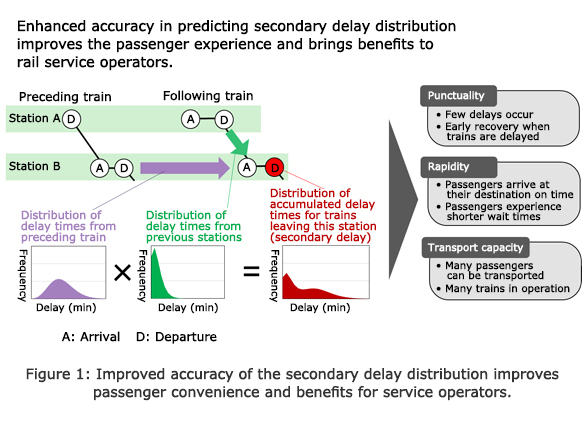Toshiba Risk Assessment Algorithm Helps Train Operators Improve Services
-Accurate calculation of delay risk reduces timetable disruption, improves services,
passenger convenience and satisfaction, and reduces workloads for railway operators-
Toshiba Corporation
TOKYO─Toshiba Corporation's (TOKYO: 6502)has developed an innovative train delay risk assessment technology that quickly and accurately calculates the probability of delays for trains operating to complex, crowded schedules. Developed for use by rail operators when timetabling services, it reduces the risk of service delays and supports the preparation of operating schedules that improve managerial and operational efficiency. Fewer delays also deliver the important pluses of improved passenger convenience and higher overall satisfaction with rail services.
The late arrivals and congested stations caused by train delays are major sources of passenger inconvenience and dissatisfaction. Secondary delays resulting from an initial delay can also cause problems during rush hours, as congestion grows at major stations where passengers are concentrated. A large ripple of secondary delays, while rare, is a particular concern, as it can severely disrupt operating schedules across a network. Rail service operators need to be on top of the situation and fully understand what is going on, and that requires accurate assessment and prediction of the risk of delays.
The usual method for evaluating secondary delays is to assume a delay scenario and to repeat simulations for an unfolding situation, what is known as a Monte Carlo simulation(Note 1). However, doing this for a major series of secondary delays requires an enormous number of simulations that impose heavy burdens of time and costs on service operators. For example, reproducing events that occur with a 0.01% probability requires a minimum of tens of thousands of simulations.
Toshiba's train delay risk assessment algorithm quickly and accurately calculates delay probabilities with any need for this kind of simulation. The algorithm, created with a probability propagation model(Note 2), is based on actual operational patterns and timetable information, and the accuracy of its calculations for secondary delays can be further fine-tuned with performance data from actual operations. As the results of these calculations are derived from a formula based on the probability propagation model, they do not require the enormous number of simulations of the Monte Carlo simulation.
The algorithm delivers fast, appropriate evaluations of risk for current timetables, and also for alternative timetable options, as secondary delay probabilities and delay times can be estimated for individual trains and stations. Producing a timetable that already incorporates train delay risk reduce disruptions in real-world operations.
The technology has been adopted by Toshiba Digital & Consulting Corporation to support its project in UK in September 2019(Note 3).
Toshiba Group is promoting a digital transformation to become one of the world's leading cyber-physical systems (CPS) technology companies, able to combine knowledge and achievements cultivated over many years in a wide range of manufacturing business domains with strengths in information processing and digital and AI technologies. The railway scheduling technology being deployed in the U.K. embodies this approach to solution provision.
Going forward, Toshiba’s researchers with further develop the scheduling technology and advance the digitization of operation planning.

- (Note 1)
- Monte Carlo simulation
A technique for observing output values by giving random numbers to the input of simulated phenomena. - (Note 2)
- Probability propagation model
A model that expresses the events of departure, arrival, and passage of each train and the ripple relation of the delay between them in a network, and that calculates the second order delay probability for each station in the network. - (Note 3)
- https://www.toshiba-sol.co.jp/en/news/detail/20190910.htm (Toshiba Digital Solutions Corporation)


